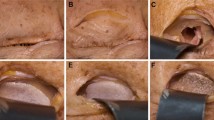Abstract
Eye orbital floor fracture is a common occurrence due to traumatic eye injuries during contact sports, motor vehicle accidents or impact by blunt objects. Another cause is a sudden increase in intra-orbital pressure. The consequences include orbital volume expansion, double vision or loss of vision in severe cases. Owing to the complex orbital anatomy, such fractures are very difficult to manage. In case of large orbital floor fracture, surgical repair or reconstruction is carried out using implants to restore the orbit and its volume. Standard titanium implants used for this purpose are flat in shape and require manual bending. The manual process is not precise and causes non-conformity of the implant surface with orbital floor and lifting of the implant at posterior end, giving unsatisfactory outcomes. This research aims at design and fabrication of orbital implants that are customized to the patient’s anatomy. This implies matching the prominent ‘S-shape’ of the orbital floor, starting from the rim and extending up to inferior orbital fissure. The design starts with the generation of 3D anatomical model from digital imaging and communications in medicine (DICOM) files obtained from the computed tomography (CT) scan of the patient. The generated 3D model is then used to design a customized orbital implant using medical CAD software, ensuring that the degree of freedom of the eye is maintained. Considering the free-form shape of the designed implant, it is additively manufactured on direct metal laser sintering (DMLS) system using titanium-(6%)aluminium-(4%)vanadium extra low interstitial (ELI) powder. After post-processing and sterilization of the fabricated implant, it was surgically implanted in the patient. The post-operative CT images revealed that customized implant was conformed to the S-shaped orbital floor, thereby providing the required stability to the implant. The orbital volume was also restored to the normal value, thus correctly aligning the affected eye with the normal eye.
Access this chapter
Tax calculation will be finalised at checkout
Purchases are for personal use only
Similar content being viewed by others
References
Baino, F.: Biomaterials and implants for orbital floor repair. Acta Biomater. 7(9), 3248–3266 (2011)
“Eye Socket Fracture (Fracture Of The Orbit),” 2019. [Online]. Available: https://www.health.harvard.edu/a_to_z/eye-socket-fracture-fracture-of-the-orbit-a-to-z. Accessed: 22-May-2020.
Seong Kim, H., Cheol Jeong, E.: Orbital floor fractures. Ophthalmic. Semin. 1(4), 451–514 (1976)
Banica, B., Ene, P., Vranceanu, D., Ene, R.: Titanium preformed implants in orbital floor reconstruction—case presentation, review of literature. Maedica (Buchar) 8(1), 34–39 (2013)
Burton, J.H., Kuehl, K.N.: Facial Trauma. [Online]. Available: https://clinicalgate.com/facial-trauma/. Accessed: 26-June-2020.
Rhim, C.H., Scholz, T., Salibian, A., Evans, G.R.: Orbital floor fractures: a retrospective review of 45 cases at a Tertiary Health Care Center. Craniomaxillofac. Trauma Reconstr. 3(1), 41–47 (2010)
Ellis, E., Tan, Y.: Assessment of internal orbital reconstructions for pure blowout fractures: cranial bone grafts versus titanium mesh. J. Oral Maxillofac. Surg. 61(4), 442–453 (2003)
Moiduddin, K.: Implementation of computer-assisted design, analysis, and additive manufactured customized mandibular implants. J. Med. Biol. Eng. 38(5), 744–756 (2018)
Prasad, K., et al.: Metallic biomaterials: current challenges and opportunities. Materials (Basel) 10(8) (2017).
Long, M., Rack, H.J.: Titanium alloys in total joint replacement—a materials science perspective. Appl. Cogn. Psychol. 8(6), 597–611 (1994)
Di Angelo, L., Di Stefano, P., Governi, L., Marzola, A., Volpe, Y.: A robust and automatic method for the best symmetry plane detection of craniofacial skeletons. Symmetry (Basel) 11(2), 1–13 (2019)
Park, J.H., et al.: Effect of cleaning and sterilization on titanium implant surface properties and cellular response. Acta Biomater. 8(5), 1966–1975 (2012)
Acknowledgements
The authors would like to thank RG Science & Technology Commission, Government of Maharashtra and the Department of Science & Technology, Government of India, for the research funding to Biomedical Engineering and Technology Innovation Centre (BETIC), Mechanical Engineering Department, IIT Bombay. The authors would also like to acknowledge the support of Mr. Mahesh Dhoka, Incredible AM Pvt. Ltd., Maharashtra, and his team for manufacturing the implants.
Author information
Authors and Affiliations
Corresponding author
Editor information
Editors and Affiliations
Rights and permissions
Copyright information
© 2021 The Author(s), under exclusive license to Springer Nature Singapore Pte Ltd.
About this paper
Cite this paper
Sagar, S. et al. (2021). Design, Additive Manufacturing and Application of Patient-Customized Orbital Implants. In: Chakrabarti, A., Poovaiah, R., Bokil, P., Kant, V. (eds) Design for Tomorrow—Volume 3. Smart Innovation, Systems and Technologies, vol 223. Springer, Singapore. https://doi.org/10.1007/978-981-16-0084-5_47
Download citation
DOI: https://doi.org/10.1007/978-981-16-0084-5_47
Published:
Publisher Name: Springer, Singapore
Print ISBN: 978-981-16-0083-8
Online ISBN: 978-981-16-0084-5
eBook Packages: EngineeringEngineering (R0)




